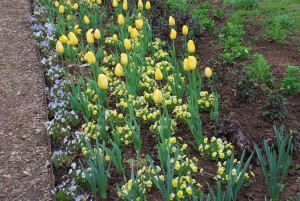If you love spring flowering tulips, daffodils and other spring-flowering bulbs, some planning and planting chores should be set into motion this fall. Spring flower bulbs should be planted when cool soil temperatures (below 55 °F) return. For gardeners living in the Southern Appalachian region (USDA hardiness zones 6 and 7), bulb planting begins in early October and ends when the ground freezes or around the first of the New Year.
Bulbs and corms (ex. crocus) should spend the winter in the cold moist ground. They may also be potted in moist soil-less media and stored in a refrigerator for 90 days or more. This mimics the outdoor garden environment. Refrigerated bulb pots can be forced to bloom indoors in February and March. Cover the pots with shrink wrap or in plastic bags to prevent the potting media from drying out or foul smelling your refrigerator.
If you have lots of bulbs to plant in the garden, invest in a power drill and an augur. Most garden centers sell augur bits. This tool makes bulb planting alot easier physically. A recommended depth chart should be available where you purchased the bulbs. Mark the proper depth on the augur with tape. After 5-6 holes, you’ll become a planting pro.
If the bulbs are planted before October 15th, consider inter-planting with winter hardy pansies and violas. Pansies will guarantee a blast of color from fall into late spring while you’re waiting for bulbs to poke through in late winter.
If you can’t plant bulbs right away, store them in a cool, dry place with good air circulation. If you purchased bulbs earlier and found them partially sprouted in the garage, plant them immediately, even if you need to use a pick axe in an icy soil. Most should come up and bloom feebly the first year.


 Posted in
Posted in 
